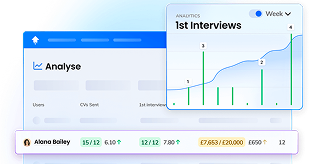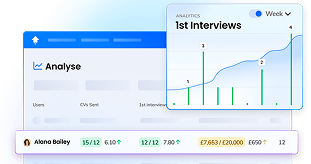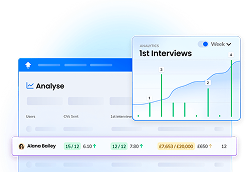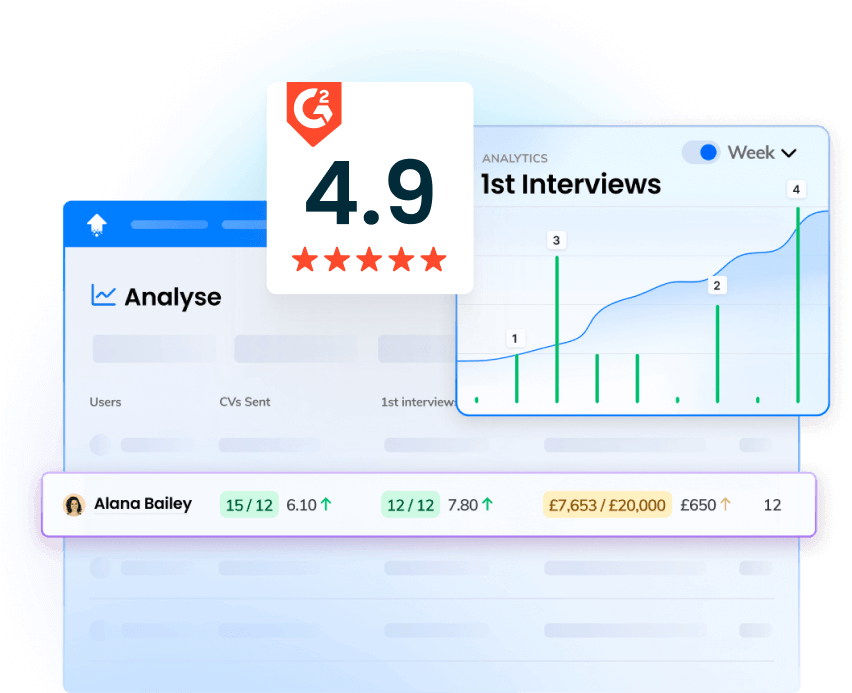In every organisation, the recruiting process generates data. You want to know how many people applied, how long it took to fill one role, and how many entry-level hires became leaders.
All of these data are just numbers if not utilised correctly.
For instance, a recruiting agency may believe that a job board brings good candidates. They can analyse the quality of hire and sourcing channel efficiency. They might find that the job board could be performing better.
The data is shown as Key Performance Indicators (KPIs) to measure how well your organisation is hiring. It makes perfect sense for businesses to use KPIs to make decisions. They need to understand factors that affect decision-making. They need to understand how those decisions are implemented. They need to know how they analyse the effectiveness of those decisions. It helps them improve their KPIs for the following year.
This blog has compiled everything you need to make the most of recruiting data. We cover everything from outreach to onboarding and beyond. So, let’s dive into it.
What are the recruiting KPIs?
KPIs are metrics that evaluate how effective and efficient your recruitment processes are. Recruiters and managers use these indicators to evaluate their work, identify improvement areas, and make the right choices.
The recruitment KPIs you choose should answer the following questions:
- What problem do you want to solve in your organisation?
- What outcome are you looking to achieve?
- How will you measure success?
- How will you know you have completed your work?
Key performance indicators are usually shown as ratios, percentages, or single-digit numbers. This way, you can quickly see how they progress towards their goals.
The Importance of KPIs in Recruitment
Traditional performance evaluation systems are broken. For years, companies and their leaders have been doing performance reviews that don't work.
Gallup says big companies spend $2.4 million to $35 million annually on performance evaluations.
Businesses must understand which aspect of their strategy needs to be fixed. They should determine the reason behind it to revamp their performance evaluation process. They need to create a system. The system provides valuable opportunities. The opportunities define employee expectations, review progress, adjust goals, and train employees individually.
And KPIs help you do that. Tracking KPIs for recruitment agencies helps assess how things work in the organisation. It provides insights into areas that need improvement. Besides this, KPIs help you:
- Take strategic decisions based on actual data and not your gut feelings.
- Save you time and money otherwise spent on analysing what went wrong.
- The recruitment metrics are a benchmark for ongoing improvement. They help you continuously optimise your recruiting processes.
- Recruiting KPIs align with a broader business strategy that supports the company's mission and vision.
- These KPIs can help you mitigate potential risks. They do this by proactively addressing issues that contribute to the overall stability of the workforce.
When you focus on the metrics impacting your business the most, you build a business roadmap. This roadmap maximises your speed toward revenue growth.
Navigating Challenges in KPI Measurement
Developing KPIs is essential to any business. Hiring teams may encounter several challenges in establishing them. Here are the top three challenges in KPI measurement:
- Problems with data: KPIs typically require pulling data from various sources. Often, data exists in silos between organisations and must be retrieved from multiple systems. Given the nature of the KPIs, it can involve a lot of back-and-forth with the executives.
- Problems with consistency: Every KPI you measure needs to be calculated similarly. Otherwise, it can influence the KPI tracking results. Even if one person makes mistakes in interpreting the data, the entire system may create inconsistencies.
- Problems with tools: Recruitment teams struggle with a lack of visibility into their data and insights into their performance due to outdated systems. Recruitment CRMs aren’t great at visualising data. They also face challenges due to manual alternatives like spreadsheets, which create an "Excel hell". Overly complex tools with a steep learning curve, such as Tableau and Power BI, add to the struggle.
- Problem with Adapting to Market Changes: The job market is always on a roll, with new trends shaping hiring decisions. That's why recruiters must be on their toes and constantly adapt to the latest changes. This makes it challenging to set and maintain consistent KPIs year over year.
- Problem with Balancing Quantity and Quality: Recruitment teams often struggle to balance the quantity (e.g., number of hires) and quality (e.g., candidate fit) of hires. Focusing too much on one aspect can negatively impact the other. Balancing quantitative and qualitative KPIs allows companies to measure achievement from different perspectives. It also helps them find areas of improvement.
17 Best Recruiting KPIs to Track in 2024
Hiring teams often make mistakes when tracking key performance indicators. They may track too many or too few KPIs. Each company has different needs, so it makes sense to choose metrics unique to their business or the areas they want to improve.
However, if you are still thinking, "Where do I start? What are the most important recruiting KPIs?" Then, you will find it helpful to track one or more of these recruitment metrics.
Note: To start with, you choose two KPIs from each category. This way, you will reduce the risk of over-relying on a single metric, which may not accurately represent business performance. Plus, having multiple KPIs provides a broader picture of the interrelationship between different aspects of businesses.
Recruitment Business Development KPIs
Key Performance Indicators (KPIs) in business development assess the success and effectiveness of business development efforts in the recruitment industry. These recruitment KPIs and metrics serve as quantifiable metrics to measure success through the performance of the recruiting team against business goals, which is crucial for making informed strategic decisions.
Here are some important Recruitment Business Development KPIs to track for a recruiting agency:
- Client Meetings Booked
- Client Calls Complete
- Jobs Added
- Revenue Booked
Client Meetings Booked
Definition: Recruiters use the "Client Meetings Booked" KPI to measure the number of client meetings booked in a specific timeframe. During these meetings, recruiters discuss clients’ recruitment needs. They evaluate possible solutions and present their services.
Why should you track it? Measuring this KPI for individual recruiters shows:
- Their effectiveness in prospecting and communicating with future clients.
- Contribution to the health of the recruitment pipeline by forecasting sales for the future.
- Gaps in employee training that need to be met.
Client Calls Complete
Definition: The "client call complete" metric measures the number of client calls completed within a specific time frame.
Why should you track it? This recruitment KPI evaluates the recruiter's ability to communicate with clients, address their needs, and offer specific solutions. Continuous client calls improve client interactions, leading to a higher engagement and retention rate.
Jobs Added
Definition: This KPI represents the job scenario quite well. Some markets, like tech, are very candidate-scarce. Others, like construction, have plenty of candidates but fewer jobs. You can collect a million candidates — but jobs or the clients behind them, that's what pays the money.
Why you should track it: "Job added" is a recruiting metric for business development since it indicates the recruiter's success in acquiring new opportunities and expanding the client base. It contributes to the overall health of the recruitment pipeline by ensuring a continuous influx of new positions to be filled.
Industry benchmark: According to SHRM, a recruiter has 30 to 40 open requisitions at any one time.
Revenue Booked
Definition: Revenue booked refers to the amount earned during an accounting period. Revenue as a KPI is widely used, particularly at the senior leadership level. It indicates the health of the business. All companies will have a revenue target they aim for, which will likely filter down through the teams.
Why you should track it: Businesses use this KPI for financial planning and strategic decision-making. An increase in revenue booked shows strong customer relationships. They are crucial for repeat business and recommendations.
Candidate Outreach and Engagement KPIs
Sourcing and outreach are critical components influencing the quantity and quality of candidates entering your talent pipeline. These metrics measure success and effectiveness in reaching out to potential candidates. They also measure success in engaging them in recruitment efforts. These recruiter KPIs evaluate the hiring managers’ success in attracting, engaging, and retaining qualified candidates.
Here are some important candidate outreach and engagement KPIs to track:
- Candidate Meetings Booked
- Candidate Calls Complete
- Candidates Added
Candidate Meetings Booked
Definition: Resumes (91%) are still considered the best way to know candidates. However, almost half of job seekers (47%) feel it's unfair to make hiring decisions solely on their resumes.

That's why many recruiters book calls with potential candidates. They do this to screen and assess their suitability for roles before their 1st interviews. The "candidate meetings booked" recruiting KPI calculates the number of meetings booked with potential candidates in a specified timeframe.
It reflects the success of the recruiting agency in sourcing quality leads. It helps to build a diverse workforce. The agency conducts face-to-face or virtual meetings to communicate job roles, assess suitability, and further explore qualifications and experience.
Why you should track it: You need more than knowing the number of applicants in your pipeline. Building a comprehensive database of job seekers and available jobs is essential. This approach goes beyond matching a candidate with a single role. It's about creating a robust talent network. By maintaining a healthy data repository of qualified candidates and potential job openings, you can swiftly match job seekers with the right roles as they become available. This proactive strategy ensures that even if a suitable role isn't immediately available for a candidate, you're well-prepared to connect them with their ideal job in the future. The key is cultivating a dynamic and well-balanced ecosystem of jobs and job seekers.
Industry benchmark: It varies depending on your industry, type of role, and sourcing channel. The more meetings you book, the more qualified candidates you will send for the next round.
Candidate Calls Complete
Definition: "Candidate calls complete" refers to the number of calls successfully conducted or completed between the recruiter and the candidates. Candidates with meaningful conversations with recruiters are more likely to be engaged and move through the recruitment pipeline, from the initial contact to the final placement.
Why you should track it: Monitoring the number of completed calls with top talent helps recruitment teams analyse patterns, identify successful strategies, and refine communication to improve their recruitment processes. This KPI is among the most tracked and important recruiting KPIs to assess a candidate's qualifications and the recruiter's communication skills to enhance client satisfaction.
Candidates Added
Definition: ‘Candidates added’ is one of the KPIs for recruiters that measures the number of new candidates added to the recruitment pipeline within a specific period. This KPI is essential for recruiters as it reflects the effectiveness of sourcing strategies and recruitment outreach efforts. A consistent increase in this number can indicate successful recruitment marketing and candidate engagement.
Why you should track it: tracking the number of ‘Candidates added’ is crucial for understanding the dynamics of your talent pool. It helps assess the reach and effectiveness of recruitment campaigns and sourcing channels. Recruitment agencies can identify trends in their talent acquisition efforts by monitoring this KPI. They can adjust strategies for better targeting and ensure a steady flow of potential candidates to meet hiring needs.
Interview and Selection Process KPIs
These recruiting KPIs and metrics measure the efficiency, effectiveness, and success of interviewing and selecting qualified candidates for job positions. A well-prepared interviewing process can imply low turnover. It can also mean high employee engagement and improved quality of successful hires.
These are some vital interview and selection process KPIs to track:
- CVs Sent
- 1st Interviews
- Contract Placements
- Permanent Placements
CVs Sent
Definition: CVs sent and interviews booked are two of the most important KPIs that 24 out of 35 clients prioritise. This quantitative metric calculates the number of qualified resumes or CVs sent to a client or a hiring manager.
Why you should track it: The primary goal of monitoring the number of CVs sent is to continuously evaluate the recruiter's ability to attract qualified candidates. It is also an effective way to calculate the ROI on the recruitment and marketing spend filling the vacancy.
Quantity is essential. However, this metric should be analysed with other metrics like quality of hire, placements made, and time to hire to ensure the quality and suitability of the presented candidates.
Industry benchmark: Recruiters should aim for a ratio of 3:1 or 4:1, meaning that one candidate is hired for every three or four qualified CVs.

1st Interviews
Definition: "1st Interviews" is a recruitment agency KPI that calculates the number of initial interviews taken among qualified candidates for a specific job in your recruiting funnel. The KPI indicates whether recruitment agencies are picking the right people for clients. The matches aren't good if many resumes are sent, but no first interviews happen. So, a high number of first interviews is what you want. Also, recruitment agencies should aim to have a certain number of these interviews booked in a given time period.
Why you should track it: This metric measures the efficiency of the recruitment agencies based on how many candidates who sent their CVs finally progressed to the first interview stage.
A higher ratio of CVs to 1st Interviews indicates that the recruiter is effectively sourcing high-quality candidates. It leads to greater client satisfaction.
Industry benchmark: Here is the average number of interviews required to hire a role in different industries:
Contract Placements
Definition: Employers are set to hire more contract workers as a hedge against uncertainty. The share of US-paid jobs posted for contractor roles increased by 26% YOY, compared to only 6% YOY full-time growth. Contractual staffing is growing, and this KPI helps you measure its impact.
Why you should track it: While it's nice to specialise in full-time recruiting, contractual hires also make up a good percentage of total employees. You can calculate this KPI to evaluate the recruiting agency's ability to fulfil the client's temporary staffing needs.
Industry benchmark: The contract workforce is growing; US businesses outsource 300,000 jobs yearly. Contract work is here to stay and shows no signs of slowing down.
Permanent Placements
Definition: "Permanent placements" is one of the crucial recruiting agency KPIs that measure the number of successful top talent placed for full-time or permanent positions.
Why you should track it: The reason to track permanent placement is two-fold:
- Successful permanent placement contributes to better candidate and manager satisfaction and efficiency in placing candidates into full-time roles.
- Tracking permanent placement allows recruitment agencies to assess their financial performance and revenue streams, contributing insights to the agency's financial health.
Recruitment Agency Operational KPIs
These recruitment agency KPIs help optimise the recruiting process by measuring the effectiveness, efficiency, and productivity of the hiring process. The key performance indicators provide information on how close (or far) you are from achieving the recruitment goals of a successful hire and facilitate strategic decision-making.
Below are some of the most operational KPIs to track:
- Time to Fill
- Quality of Hire
- Offer Acceptance Rate
Time to Fill
Definition: Time to fill represents the number of days taken to fill an open position. It starts when the job ad goes live until a suitable candidate is chosen and the hiring process closes.
Why you should track it: Time to fill is a valuable recruiting KPI that helps identify whether your hiring process is slow.
A slow hiring process can cause enormous costs, which can be divided into two major categories:
- The external budget: these recruiting costs are incurred by placing job advertisements on job boards.
- The cost of a vacant position: it includes all the costs incurred by the company due to an unoccupied position — for instance, loss of sales due to production restrictions or failure to provide customer support.
This recruitment agency KPI is a solid indication of your recruiting efforts — a shorter time to fill means happier clients and more revenue.
Industry benchmark: On average, it takes 35 days to fill a role.

Quality of Hire
Definition: The quality of hire is the top metric companies track because it's notoriously difficult to measure. It evaluates the long-term business impact of new employees.
You can only calculate this metric several months after the role is filled. There is no single calculation. Most businesses define quality of hire as a combination of three factors. These are employee retention, engagement, and performance ratings.
Why you should track it: The hire's quality measures the recruiting team's choices.
A single bad hire can cost the company anything between $14,900 to $18,700. This cost includes hiring compensation, lost productivity, employee turnover, and disruptions to workflow. It's extremely important to be cautious about whom you are hiring, and this cannot be ignored. From a recruitment agency's perspective, a poor hire that doesn't complete their probation period can mean lost revenue as the job wasn't successfully filled.
Formula: You need to consider two things when calculating the "quality of hire":
- Pre-hire quality: This evaluates whether the pool of candidates an organisation receives can perform the job to your satisfaction. You can give out surveys to your hiring managers and ask how satisfied they were with the candidates they received for a job post.
- Post-hire quality: Several factors contribute to post-hire quality: job performance, retention rate, productivity, and overall engagement. Score (between 1-100) your hire based on their performance on these parameters.
Industry benchmark: No industry benchmark exists since you have to define your quality parameters.
Offer Acceptance Rate
Definition: The "Offer Acceptance Rate" refers to the percentage of candidates who accept the position. A high offer acceptance rate means you attract and hire suitable candidates. This is due to competitive compensation, employee benefits, and other incentives.
Why you should track it: This KPI highlights the ability of the recruitment team to identify a candidate's priorities, requirements, and objections that might stop a candidate from accepting the offer.
According to Gem's 2023-Recruiting trends, the most common reasons why a candidate might reject your offers are low compensation, longer hiring processes, concerns about career growth, and more.
Industry benchmark: According to SHRM's Talent Acquisition Benchmarking Report, a high offer acceptance rate is considered to be around 90% or higher. However, engineering candidates have the lowest offer acceptance rate (58.5%), while accounting management candidates have the highest (73.0%).
Candidate Experience KPIs
From the moment candidates browse your career page until they receive an offer letter or a rejection email, they form an opinion about your company. They consider how you generally treat your candidates.
Why is tracking this important? With websites like Indeed.com and Glassdoor, 86% of candidates research how a company treats its employees before applying. Negative reviews can get you low quality and quantity of candidates and take you more time to fill up positions.
There are several ways to measure candidate experience, including:
- Candidate Experience (Candidate Net Promoter Score)
- Application Completion Rate
- Retention Rate
Candidate Experience (Candidate Net Promoter Score)
Definition: Candidate experience starts with communication, and hiring teams must improve it. Research by Talentegy says that the majority, 63.2%, indicate they are dissatisfied or very dissatisfied with the communication they receive after application.
Candidate Net Promoter Score is a method to calculate how much your candidate likes or dislikes your hiring process. Very similar to how the marketing and sales team evaluates the customer journey, customer feedback helps businesses determine what's important to them.
Why you should track it: In the previous job markets, hiring managers had the luxury of being less communicative and running hiring according to their desires. That's just not going to cut it in today's competitive talent landscape.
Candidate Net Promoter Score helps you measure how candidates view your hiring process and what they might tell others after applying and interviewing for a role in a company.
Formula: Send a short, voluntary survey to every candidate. Rate the hiring process on a scale of 0–10, with 0 being "not at all likely" and 10 being "very likely." Include questions like:
- Did the job description help you understand the role?
- How would you rate the level of communication with recruiters/hiring managers through email, phone, or video calls?
- Would you apply for a future opening in our company?
- Would you encourage your family or friends to apply to our company?
- What's the one thing you liked and disliked about the hiring process?
- Is there anything you would like to change in our hiring process?
When you get responses from candidates, you can aggregate the results to create reports. You can also create simple pie charts or bar graphs indicating areas for improvement.
Industry benchmark: Your NPSs can be divided into three categories:
- Promoters: Candidates that give a score of 9 or 10, which means they are happy with the hiring process and will most likely recommend your company to other candidates.
- Passive or Neutral: Candidates who give a score between 7 and 8 will either promote the company or say something terrible about it.
- Detractors: Candidates who give between 0 and 6 are dissatisfied and unhappy with the hiring process and are most likely not to recommend it to others.
Application Completion Rate
Definition: Application completion rate is the ratio of applicants who initiate an application process and successfully submit it for review.
Why you should track it: The problem of job candidates abandoning applications continues to scare hiring teams. A lower completion rate can be a sign of bigger problems and missed opportunities.
According to SHRM:
- 92% of job seekers never finish an application because of the lengthy process.
- 60% of job seekers quit filling out the application form because of its length and complexity.
- Completion rates drop by almost 50% when an application asks more than 50 questions vs 25 questions or fewer questions.
- Job descriptions with less than 250 words and more than 2000 words show a high abandonment rate.
- More than 70% of candidates will not apply if it takes 15 minutes or more to complete.
Whatever the reason, the result is the same - missed opportunities. When you are recruiting at volume, you need to fill positions quickly. If an applicant starts and does not finish, you could miss out on a potentially significant candidate.
Industry benchmark: On average, 10.6% of job seekers will complete a job application that asks fewer than 25 questions.

Retention Rate
Definition: Employee retention is among the most crucial recruiting KPIs that measure the percentage of employees who stay at your company over a specific period. This KPI tells a lot about how you treat your employees and the quality of your hiring team.
Why you should track it: On average, 27 out of every 100 employees quit voluntarily, with over one-third leaving in the first year. For every employee that goes, it costs 33% of their base pay, or approximately $15,000. It includes administrative costs, replacement costs, training costs, and productivity losses.
The top three reasons why employees leave an organisation are:
- Lack of growth opportunities
- Job stress and less work-life balance
- Health and family issues (work-related and non-work-related)
If you are experiencing high turnover, you should address the problem quickly. Remember that the most frequently cited reason for leaving an organisation is not always the most important.
Industry benchmark: The ideal employee retention rate is 90% or higher, indicating that employee turnover should not be less than 10%.
Interpreting KPI Data for Recruitment Optimisation
It is said that "what gets measured gets done," and that's what we will do next. Here is a step-by-step method for how you can track your recruiting KPIs and assess the success of your recruitment process:
Determine your end goal
Not all metrics are worth tracking; too many can cause unnecessary work that might be useless. Instead, choose a few key metrics for your business objective.
Set a clear vision for what you want to achieve. Without this, you risk working towards something that wastes your time, money, and resources.
For instance, if you want to improve your jobs pipeline, defining and tracking specific pipeline metrics is crucial. These include Jobs Added, CVs Sent, Interviews Booked, and Placements Filled.
By focusing on these metrics, you can identify areas for improvement in your recruitment process. The key is to optimise the ratio between these metrics. It ensures a more efficient and effective pipeline. Ultimately, it leads to successful candidate placements.
Make sure to choose the right KPIs
Every KPI you choose should help measure a clearly defined goal you are trying to achieve. One of the most innovative ways to evaluate the effectiveness of your selected KPI is to ask the following questions using the SMART criteria:
- How SPECIFIC is your goal?
- Is it MEASURABLE?
- How ATTAINABLE is it?
- Is it RELEVANT to the business?
- What is the TIME required to meet these goals?
If your answer is "NO" to any of these questions, your KPI must be refined or replaced.
Assign responsibility for each KPI to specific individuals
KPIs are crucial for measuring performance, but they are most likely to be acted upon when someone is responsible for tracking and reporting them. Ensure you clearly explain how individuals and teams measure and track a KPI. They should be accountable for data collection and interpretation, and for presenting KPI reports to stakeholders.
Monitor and report your KPIs
Finally, it's necessary to continuously monitor your recruitment analytics monthly, quarterly, half-yearly, or annually. Regular monitoring makes it easy to spot areas that are underperforming or overperforming.
Ensure all relevant parties associated with the findings are communicated because goals and KPIs are often connected. For example, one recruiter is adding many new jobs but is not successfully placing any candidates. In that case, these are red flags to determine where there may be problems in the recruitment funnel.
Technology in KPI Tracking and Analysis
It has never been a more critical time for recruitment teams to be adaptable, especially when it comes to how they hire. Over the past years, recruiters have leveraged technology in hiring, retaining, and managing talent to remain competitive. And they already use tools like CRMs, ATSs, and Timesheet software. But the key is to really use the data from these tools well.
Recruitment teams should focus on understanding their data better and using it to automate parts of their process. It will make recruiters’ jobs easier and help them find the right people for jobs more efficiently.
Data is driving the future of recruiting, and here's how:
Bringing transparency to performance
By bringing together data from multiple systems and visualising this in an easy and accessible way, recruiters and their managers have access to real-time data and insights that they haven't before. This streamlined approach simplifies performance tracking, forecasting, and team management, making these processes more efficient and effective.
Automating recurring reports
Traditionally, the recruitment industry heavily relied on manual spreadsheets for data reporting. This takes time, causes errors, and means data is already out-of-date when it's being analysed. Automating these reports removes these inefficiencies, freeing up valuable time for the team to concentrate on critical tasks.
Optimising pipelines and performance
Having access to real-time data and analysis means that it's easy to understand what truly helps the agency meet its goals. This can help set future KPIs and improve productivity and performance.
Face the challenge
Jobsync's latest report shows that the main reasons why TA teams continue to use manual spreadsheets rather than adopting talent technology include concerns over lack of ease of use, integration capabilities, cost, ROI, and reliability.
None of the challenges can be ignored if you want to measure your KPIs accurately.
However, a simpler tool that does all the KPI tracking without manually adding data or running calculations would be helpful. And that's where OneUp comes into play.
OneUp is a dedicated recruitment analytics tool designed for real-time data monitoring, so your business can get visibility into your KPIs in minutes, not hours.
![]()
With OneUp, you can:
- Build a custom recruitment KPIs template and set your hiring team's mission, challenges, and targets.
- Cut your manual work and show tracked KPIs on the dashboard.
- Display real-time recruitment dashboards to see how they are performing against top performers.
- Review performance in real-time.
- Visualise performance for any given metric over a day, week, month, quarter, or year.
You can implement OneUp to create KPIs designed to reflect the real world. The platform easily integrates with your data sources and keeps track of everything in your recruitment agency.
Over to you
Tracking KPIs can help you get insights into how your businesses can make better hiring decisions. It also shows the efficiency and effectiveness of your hiring team, including areas that need improvement.
But it's easy to get lost in data for hours to generate a simple KPI report. Adopting dedicated recruiter analytics software will simplify your reporting process and give you time to focus on activities that need your attention.




























